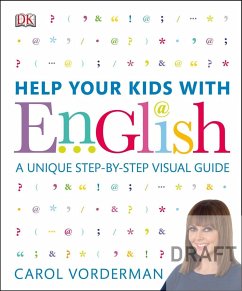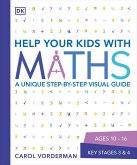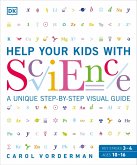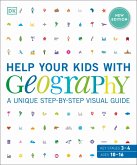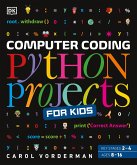Carol Vorderman
Help Your Kids with English, Ages 10-16 (Key Stages 3-4)
A Unique Step-by-Step Visual Guide, Revision and Reference
22,99 €
inkl. MwSt.
Versandfertig in 2-4 Wochen

11 °P sammeln
Carol Vorderman
Help Your Kids with English, Ages 10-16 (Key Stages 3-4)
A Unique Step-by-Step Visual Guide, Revision and Reference
- Broschiertes Buch
- Merkliste
- Auf die Merkliste
- Bewerten Bewerten
- Teilen
- Produkt teilen
- Produkterinnerung
- Produkterinnerung
Suitable for every frustrated parent and desperate child, who wants to understand English and put what they've learnt into practice, this title uses pictures, diagrams to cover all the important areas including punctuation, grammar, spelling, and communication skills, so you can approach even the most complex English concepts with confidence.
Andere Kunden interessierten sich auch für
![Help Your Kids with Maths, Ages 10-16 (Key Stages 3-4) Help Your Kids with Maths, Ages 10-16 (Key Stages 3-4)]() Carol VordermanHelp Your Kids with Maths, Ages 10-16 (Key Stages 3-4)17,99 €
Carol VordermanHelp Your Kids with Maths, Ages 10-16 (Key Stages 3-4)17,99 €![Help Your Kids with Science Help Your Kids with Science]() Carol VordermanHelp Your Kids with Science22,99 €
Carol VordermanHelp Your Kids with Science22,99 €![Help Your Kids with Music, Ages 10-16 (Grades 1-5) Help Your Kids with Music, Ages 10-16 (Grades 1-5)]() Carol VordermanHelp Your Kids with Music, Ages 10-16 (Grades 1-5)16,99 €
Carol VordermanHelp Your Kids with Music, Ages 10-16 (Grades 1-5)16,99 €![The Tiger Mum Who Came to Tea The Tiger Mum Who Came to Tea]() Uttom ChowdhuryThe Tiger Mum Who Came to Tea23,99 €
Uttom ChowdhuryThe Tiger Mum Who Came to Tea23,99 €![Help Your Kids with Geography, Ages 10-16 (Key Stages 3 & 4) Help Your Kids with Geography, Ages 10-16 (Key Stages 3 & 4)]() DKHelp Your Kids with Geography, Ages 10-16 (Key Stages 3 & 4)22,99 €
DKHelp Your Kids with Geography, Ages 10-16 (Key Stages 3 & 4)22,99 €![Computer Coding Python Projects for Kids Computer Coding Python Projects for Kids]() Carol VordermanComputer Coding Python Projects for Kids24,99 €
Carol VordermanComputer Coding Python Projects for Kids24,99 €![Help Your Child Feel Happier Help Your Child Feel Happier]() Caroline RoopeHelp Your Child Feel Happier17,99 €
Caroline RoopeHelp Your Child Feel Happier17,99 €-
-
-
Suitable for every frustrated parent and desperate child, who wants to understand English and put what they've learnt into practice, this title uses pictures, diagrams to cover all the important areas including punctuation, grammar, spelling, and communication skills, so you can approach even the most complex English concepts with confidence.
Hinweis: Dieser Artikel kann nur an eine deutsche Lieferadresse ausgeliefert werden.
Hinweis: Dieser Artikel kann nur an eine deutsche Lieferadresse ausgeliefert werden.
Produktdetails
- Produktdetails
- DK Help Your Kids With
- Verlag: Dorling Kindersley / Dorling Kindersley UK
- Seitenzahl: 256
- Altersempfehlung: von 10 bis 12 Jahren
- Erscheinungstermin: 3. Juni 2013
- Englisch
- Abmessung: 238mm x 197mm x 20mm
- Gewicht: 818g
- ISBN-13: 9781409314943
- ISBN-10: 1409314944
- Artikelnr.: 36419962
- Herstellerkennzeichnung
- Libri GmbH
- Europaallee 1
- 36244 Bad Hersfeld
- gpsr@libri.de
- DK Help Your Kids With
- Verlag: Dorling Kindersley / Dorling Kindersley UK
- Seitenzahl: 256
- Altersempfehlung: von 10 bis 12 Jahren
- Erscheinungstermin: 3. Juni 2013
- Englisch
- Abmessung: 238mm x 197mm x 20mm
- Gewicht: 818g
- ISBN-13: 9781409314943
- ISBN-10: 1409314944
- Artikelnr.: 36419962
- Herstellerkennzeichnung
- Libri GmbH
- Europaallee 1
- 36244 Bad Hersfeld
- gpsr@libri.de
Carol Vorderman
- 1: Foreword
- 2: Why learn the rules?
- 3: Spoken and written language
- 4: English around the world
- 5: Grammar
- 1: The purpose of grammar
- 2: Parts of speech
- 3: Nouns
- 4: Plurals
- 5: Adjectives
- 6: Comparatives and superlatives
- 7: Articles
- 8: Determiners
- 9: Pronouns
- 10: Number and gender
- 11: Verbs
- 12: Adverbs
- 13: Simple tenses
- 14: Perfect and continuous tenses
- 15: Participles
- 16: Auxiliary verbs
- 17: Irregular verbs
- 18: Verb agreement
- 19: Voices and moods
- 20: Phrasal verbs
- 21: Conjunctions
- 22: Prepositions
- 23: Interjections
- 24: Phrases
- 25: Clauses
- 26: Sentences
- 27: Compound sentences
- 28: Complex sentences
- 29: Using clauses correctly
- 30: Managing modifiers
- 31: Commonly misused words
- 32: Negatives
- 33: Relative clauses
- 34: Idioms, analogies and figures of speech
- 35: Colloquialisms and slang
- 36: Direct and indirect speech
- 6: Punctuation
- 1: What is punctuation?
- 2: Full stops and ellipses
- 3: Commas
- 4: Other uses of commas
- 5: Semi-colons
- 6: Colons
- 7: Apostrophes
- 8: Hyphens
- 9: Inverted commas
- 10: Question marks
- 11: Exclamation marks
- 12: Brackets and dashes
- 13: Bullet points
- 14: Numbers, dates and time
- 15: Other punctuation
- 16: Italics
- 7: Spelling
- 1: Why learn to spell?
- 2: Alphabetical order
- 3: Vowel sounds
- 4: Consonant sounds
- 5: Syllables
- 6: Morphemes
- 7: Understanding English irregularities
- 8: Roots
- 9: Prefixes and suffixes
- 10: Hard and soft letter sounds
- 11: Words ending in -e or -y
- 12: Words ending in -tion, -sion or -ssion
- 13: Words ending in -able or -ible
- 14: Words ending in -le, -el, -al or -ol
- 15: Single and double consonant words
- 16: The "i before e except after c" rule
- 17: Capital letters
- 18: Silent letters
- 19: Compound words
- 20: Irregular word spellings
- 21: Homonyms, homophones and homographs
- 22: Confusing words
- 23: Other confusing words
- 24: Abbreviations
- 25: British and American spellings
- 26: More British and American spellings
- 8: Communication skills
- 1: Effective communication
- 2: Picking the right words
- 3: Making sentences interesting
- 4: Planning and research
- 5: Paragraphing
- 6: Genre, purpose and audience
- 7: Reading and commenting on texts
- 8: Layout and presentational features
- 9: Writing to inform
- 10: Newspaper articles
- 11: Letters and e-mails
- 12: Writing to influence
- 13: Writing to explain or advise
- 14: Writing to analyse or review
- 15: Writing to describe
- 16: Writing from personal experience
- 17: Writing a narrative
- 18: Writing for the Web
- 19: Writing a script
- 20: Re-creations
- 21: Checking and editing
- 22: The spoken word
- 23: Debates and role plays
- 24: Writing a speech
- 25: Presentation skills
- 8: Reference
- 1: Reference - Grammar
- 2: Reference - Punctuation
- 3: Reference - Spelling
- 4: Reference - Communication skills
- 5: Glossary
- 6: Index
- 7: Acknowledgements
- 1: Foreword
- 2: Why learn the rules?
- 3: Spoken and written language
- 4: English around the world
- 5: Grammar
- 1: The purpose of grammar
- 2: Parts of speech
- 3: Nouns
- 4: Plurals
- 5: Adjectives
- 6: Comparatives and superlatives
- 7: Articles
- 8: Determiners
- 9: Pronouns
- 10: Number and gender
- 11: Verbs
- 12: Adverbs
- 13: Simple tenses
- 14: Perfect and continuous tenses
- 15: Participles
- 16: Auxiliary verbs
- 17: Irregular verbs
- 18: Verb agreement
- 19: Voices and moods
- 20: Phrasal verbs
- 21: Conjunctions
- 22: Prepositions
- 23: Interjections
- 24: Phrases
- 25: Clauses
- 26: Sentences
- 27: Compound sentences
- 28: Complex sentences
- 29: Using clauses correctly
- 30: Managing modifiers
- 31: Commonly misused words
- 32: Negatives
- 33: Relative clauses
- 34: Idioms, analogies and figures of speech
- 35: Colloquialisms and slang
- 36: Direct and indirect speech
- 6: Punctuation
- 1: What is punctuation?
- 2: Full stops and ellipses
- 3: Commas
- 4: Other uses of commas
- 5: Semi-colons
- 6: Colons
- 7: Apostrophes
- 8: Hyphens
- 9: Inverted commas
- 10: Question marks
- 11: Exclamation marks
- 12: Brackets and dashes
- 13: Bullet points
- 14: Numbers, dates and time
- 15: Other punctuation
- 16: Italics
- 7: Spelling
- 1: Why learn to spell?
- 2: Alphabetical order
- 3: Vowel sounds
- 4: Consonant sounds
- 5: Syllables
- 6: Morphemes
- 7: Understanding English irregularities
- 8: Roots
- 9: Prefixes and suffixes
- 10: Hard and soft letter sounds
- 11: Words ending in -e or -y
- 12: Words ending in -tion, -sion or -ssion
- 13: Words ending in -able or -ible
- 14: Words ending in -le, -el, -al or -ol
- 15: Single and double consonant words
- 16: The "i before e except after c" rule
- 17: Capital letters
- 18: Silent letters
- 19: Compound words
- 20: Irregular word spellings
- 21: Homonyms, homophones and homographs
- 22: Confusing words
- 23: Other confusing words
- 24: Abbreviations
- 25: British and American spellings
- 26: More British and American spellings
- 8: Communication skills
- 1: Effective communication
- 2: Picking the right words
- 3: Making sentences interesting
- 4: Planning and research
- 5: Paragraphing
- 6: Genre, purpose and audience
- 7: Reading and commenting on texts
- 8: Layout and presentational features
- 9: Writing to inform
- 10: Newspaper articles
- 11: Letters and e-mails
- 12: Writing to influence
- 13: Writing to explain or advise
- 14: Writing to analyse or review
- 15: Writing to describe
- 16: Writing from personal experience
- 17: Writing a narrative
- 18: Writing for the Web
- 19: Writing a script
- 20: Re-creations
- 21: Checking and editing
- 22: The spoken word
- 23: Debates and role plays
- 24: Writing a speech
- 25: Presentation skills
- 8: Reference
- 1: Reference - Grammar
- 2: Reference - Punctuation
- 3: Reference - Spelling
- 4: Reference - Communication skills
- 5: Glossary
- 6: Index
- 7: Acknowledgements
